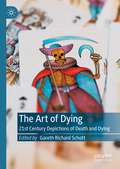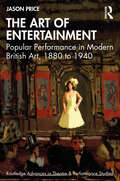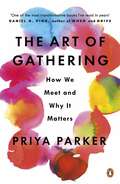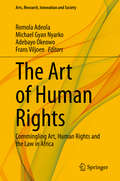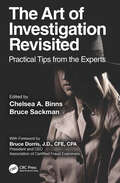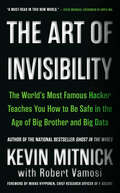- Table View
- List View
The Art of Dying: 21st Century Depictions of Death and Dying
by Gareth Richard SchottThe Art of Dying: 21st Century Depictions of Death and Dying examines how contemporary media platforms are used to produce creative accounts, responses and reflections on the course of dying, death and grief. Outside the public performance of grief at funerals, grief can strike in anticipation of a loss, or it can endure, continuing to interject itself and interrupt a permanently changed life. This book examines the particular affordances possessed by various contemporary creative forms and platforms that capture and illuminate different aspects of the phenomenology of dying and grief. It explores the subversive and unguarded nature of stand-up comedy, the temporal and spatial inventiveness of graphic novels, the creative constructions of documentary filmmaking, the narrative voice of young adult literature, the realism of documentary theatre, alongside more ubiquitous media such as social media, television and games. This book is testament to the power of creative expression to elicit vicarious grief and sharpen our awareness of death.
The Art of Economic Persuasion: Positive Incentives and German Economic Diplomacy
by Patricia A. DavisMuch has been written about a state's use of the threat of military force or economic sanctions to change the behavior of another state. Less is known about the use of positive measures such as economic assistance and investment as a means of influence. This study looks at the ways in which government officials use economic instruments for foreign policy gains. More specifically, it examines the means by which a government can enhance its efforts at economic persuasion by inducing domestic business trade and investing in the target nation. The author demonstrates the domestic conditions under which the state can use commercial economic incentives to achieve foreign policy goals, especially where these incentives are meant to induce cooperative behavior from another state. Using the process of German-Polish reconciliation in the 1970s and 1980s as a case study, The Art of Economic Persuasion, argues that complex institutional links between the German government and the German business community enabled the government to encourage commercial relations with Poland, which supported the government's policies. With singular access to archives of business associations in Germany as well as numerous interviews with German and Polish officials, the author carefully retraces German foreign policy towards Poland in the 1970s and 1980s. The Art of Economic Persuasion is a theoretical addition to the literature on international political economy and international relations. It will be of interest to specialists in international relations, foreign policy, and international political economy, as well as economists, political scientists, and historians of Germany, Poland, the United States, and Cold War relations. Patricia Davis is Assistant Professor of Government and International Studies, University of Notre Dame.
The Art of Effective Science Communication: A Performer's Guide to Public Speaking (Palgrave Practical Guides in Communication)
by David DannenfelserThis book shows readers how the arts of improvisational theater and acting can help scientists and other experts speak about technical research to lay audiences.Focused on public speaking, this book translates the principles and processes used by actors and other theater professionals into a method for communicating science to the general public. The book is structured as a step-by-step examination of how to write an effective speech and then a guide to carefully analyzing that speech as an actor does in rehearsal before finally sharing it with an audience as a performance. In other words, the book helps science communicators identify what to say and how to say it. This book also includes prompts and exercises that the author has used in classes and workshops with scientists.
The Art of Empirical Investigation
by James E. Katz Julian L. SimonJulian Simon was known for his methodical, and often controversial, writings challenging conventional beliefs about overpopulation, pollution, disappearing farmland, and the scarcity of energy sources and raw materials. But throughout his works is a common theme: that responsible, unbiased research and examination of the data is indispensable to formulating a well-informed and accurate opinion. The Art of Empirical Investigation teaches student, professor, researcher, and those interested in ascertaining the truth about social issues just how to proceed.The Art of Empirical Investigation is a textbook on the basics of social-scientific research. It discusses all the important empirical methods used in social science, and its examples, drawn from a wide variety of academic and applied fields, illustrate the use of each method in its most appropriate context. The actual decisions a researcher must make at every stage of a project are emphasized, as well as obstacles to knowledge--such as observer bias, deception, unreliability of data, and sampling costs--and how to overcome them. Presupposing nothing, the book introduces the reader to the foundations of empirical social-science research, regardless of a specific field. It also makes an important contribution to beginning researchers' understanding of an operational definition of causality, which cuts through philosophical obscurity and teaches the researcher how to decide whether or not a given relationship is causal.
The Art of Empirical Investigation
by Julian SimonJulian Simon was known for his methodical, and often controversial, writings challenging conventional beliefs about overpopulation, pollution, disappearing farmland, and the scarcity of energy sources and raw materials. But throughout his works is a common theme: that responsible, unbiased research and examination of the data is indispensable to formulating a well-informed and accurate opinion. The Art of Empirical Investigation teaches student, professor, researcher, and those interested in ascertaining the truth about social issues just how to proceed.The Art of Empirical Investigation is a textbook on the basics of social-scientific research. It discusses all the important empirical methods used in social science, and its examples, drawn from a wide variety of academic and applied fields, illustrate the use of each method in its most appropriate context. The actual decisions a researcher must make at every stage of a project are emphasized, as well as obstacles to knowledge--such as observer bias, deception, unreliability of data, and sampling costs--and how to overcome them. Presupposing nothing, the book introduces the reader to the foundations of empirical social-science research, regardless of a specific field. It also makes an important contribution to beginning researchers' understanding of an operational definition of causality, which cuts through philosophical obscurity and teaches the researcher how to decide whether or not a given relationship is causal.
The Art of Entertainment: Popular Performance in Modern British Art, 1880 to 1940 (ISSN)
by Jason PriceIn this book, theatre historian Jason Price looks at the relationships and exchanges that took place between high and low cultural forms in Britain from 1880 to 1940, focusing on the ways in which figures from popular entertainments, such as music hall serio-comics, clowns, and circus acrobats, came to feature in modern works of art.Readers with an interest in art, theatre, and the history of modern Britain will find Price’s approach, which sees major works of art used to illuminate the histories of once-famous entertainers and the wider social, political, and cultural landscape of this period, accessible and engaging. The book will bring to life for readers some of the most vivid works of modern British art and reveal how individuals historically overlooked due to their gender, sexuality, or race played a significant role in the shaping of British culture during this period of monumental social change.
The Art of Entertainment: Popular Performance in Modern British Art, 1880 to 1940 (ISSN)
by Jason PriceIn this book, theatre historian Jason Price looks at the relationships and exchanges that took place between high and low cultural forms in Britain from 1880 to 1940, focusing on the ways in which figures from popular entertainments, such as music hall serio-comics, clowns, and circus acrobats, came to feature in modern works of art.Readers with an interest in art, theatre, and the history of modern Britain will find Price’s approach, which sees major works of art used to illuminate the histories of once-famous entertainers and the wider social, political, and cultural landscape of this period, accessible and engaging. The book will bring to life for readers some of the most vivid works of modern British art and reveal how individuals historically overlooked due to their gender, sexuality, or race played a significant role in the shaping of British culture during this period of monumental social change.
The Art of Environmental Activism in Indonesia: Shifting Horizons (Routledge Contemporary Southeast Asia Series)
by Edwin JurriënsThis book analyses the intersections between contemporary art and environmental activism in Indonesia. Exploring how the arts have promoted ecological awareness from the late 1960s to the early 2020s, the book shows how the arts have contributed to societal change and public and political responses to environmental crises. This period covers Indonesia’s rapid urban development under the totalitarian New Order regime (1967–1998) as well as the enhanced freedom of expression, alternative development models, and environmental problems under the democratic governments since 1998. The book applies the concept of ‘artivism’ to refer to the vital role of art in activism. It seeks to identify and contextualise both the potential and limits of environmental artivism in Indonesia, a country whose vibrant art scenes and monumental social transformations provide a productive laboratory for exploring the power of creativity as a social and political change agent. It provides a comprehensive overview of contemporary art from Indonesia, with an in-depth analysis of artivists who seek to address and find solutions for some of the most pressing environmental issues of our times. With its detailed, empirical approach to environmental art from Southeast Asia, this project fills in an important gap in the literature on art and activism. It is aimed at academics, students, artists, curators, policymakers, activists, and general readers with an interest in the environment, art history, and Indonesian culture, society, and politics.
The Art of Environmental Activism in Indonesia: Shifting Horizons (Routledge Contemporary Southeast Asia Series)
by Edwin JurriënsThis book analyses the intersections between contemporary art and environmental activism in Indonesia. Exploring how the arts have promoted ecological awareness from the late 1960s to the early 2020s, the book shows how the arts have contributed to societal change and public and political responses to environmental crises. This period covers Indonesia’s rapid urban development under the totalitarian New Order regime (1967–1998) as well as the enhanced freedom of expression, alternative development models, and environmental problems under the democratic governments since 1998. The book applies the concept of ‘artivism’ to refer to the vital role of art in activism. It seeks to identify and contextualise both the potential and limits of environmental artivism in Indonesia, a country whose vibrant art scenes and monumental social transformations provide a productive laboratory for exploring the power of creativity as a social and political change agent. It provides a comprehensive overview of contemporary art from Indonesia, with an in-depth analysis of artivists who seek to address and find solutions for some of the most pressing environmental issues of our times. With its detailed, empirical approach to environmental art from Southeast Asia, this project fills in an important gap in the literature on art and activism. It is aimed at academics, students, artists, curators, policymakers, activists, and general readers with an interest in the environment, art history, and Indonesian culture, society, and politics.
The Art of Faking It: Sounding Smart Without Really Knowing Anything
by Laurence Whitted-FryIn today's fast-paced society, who has time to keep up with both the current trends and the classics of what is "good” and "popular”? The Art of Faking It guides you-with tongue planted firmly in cheek-through any awkward, intellectual, and/or über-sophisticated social situation, using both panache and pithy nuggets of wisdom to ensure you'll never be at a loss for the right words and attitudes again.Inside you will find everything you need to know about what everyone is talking about- from ordering the "right” food and drink to holding an intelligent conversation about anything, from classical music and architecture to legitimate theater and the opposite sex. With the timely information and savvy advice in this book, playfully illustrated with New Yorker-esque line drawings, you will be the most scintillating conversationalist in the bunch-whether you are faking it or not!
The Art of Fate Calculation: Practicing Divination in Taipei, Beijing, and Kaifeng (Asian Anthropologies #14)
by Stéphanie HomolaFrom housewives to students and high-ranking officials, people from all social backgrounds in China and Taiwan visit fate calculation masters to learn about their destiny. How do clients assess the diviner’s skills? How does one become a fortune-teller? How is a person’s fate calculated? The Art of Fate Calculation explores how conceptions of fate circulate in Chinese and Taiwanese societies while resisting uniformization and institutionalization. This is not only due to the stigma of “superstition” but also to the internal dynamic of fate calculation practice and learning.
The Art of Fate Calculation: Practicing Divination in Taipei, Beijing, and Kaifeng (Asian Anthropologies #14)
by Stéphanie HomolaFrom housewives to students and high-ranking officials, people from all social backgrounds in China and Taiwan visit fate calculation masters to learn about their destiny. How do clients assess the diviner’s skills? How does one become a fortune-teller? How is a person’s fate calculated? The Art of Fate Calculation explores how conceptions of fate circulate in Chinese and Taiwanese societies while resisting uniformization and institutionalization. This is not only due to the stigma of “superstition” but also to the internal dynamic of fate calculation practice and learning.
The Art of Gathering: Create Transformative Meetings, Events and Experiences
by Priya ParkerWe spend our lives gathering - first in classrooms and then in meetings, weddings, conferences and away days. Yet so many of us spend this time in underwhelming moments that fail to engage us, inspire us, or connect us. We've all sat in meetings where people talk past each other or go through the motions and others which galvanize a team and remind everyone why they first took the job. We've been to weddings that were deeply moving and others that were run-of-the-mill and simply faded away. Why do some moments take off and others fizzle? What's the difference between the gatherings that inspire you and the ones that don't? In The Art of Gathering, Priya Parker gets to the heart of these questions and reveals how to design a transformative gathering. An expert on organizing successful gatherings whether in conference centres or her living room, Parker shows us how to create moving, magical, mind-changing experiences - even in spaces where we've come to expect little.
The Art of Helping Others: Being Around, Being There, Being Wise
by Heather Smith Mark K. SmithWhen searching for someone to help them reflect upon and improve their lives, people tend to be drawn towards those who are compassionate, committed and wise. This book is aimed at those who recognise these qualities in themselves and wish to develop their capacity to engage with and help others.
The Art of Human Rights: Commingling Art, Human Rights and the Law in Africa (Arts, Research, Innovation and Society)
by Romola Adeola Michael Gyan Nyarko Adebayo Okeowo Frans ViljoenThis book highlights the use of art in human rights, specifically within Africa. It advances an innovative pattern of thinking that explores the intersection between art and human rights law. In recent years, art has become an important tool for engagement on several human rights issues. In view of its potency, and yet potential to be a danger when misused, this book seeks to articulate the use of arts in the human rights discourse in its different forms. Chapters cover how music, photography, literature, photojournalism, soap opera, commemorations, sculpting and theatre can be used as an expression of human rights. This book demonstrates how arts have become a formidable expression of thoughts and a means of articulating reality in a form that simplifies truth and congregates resolve to advance change.
The Art of Identity: Creating and Managing a Successful Corporate Identity
by Mark RowdenThis title was first published in 2000: This text redefines corporate identity. It offers an insight into the creation, management and measurement of identity - and into why the right identity can transform your organization. With the help of tests and illustrations, Mark Rowden challenges readers to jettison ineffectual compromises and half-baked solutions in order to achieve the identity that really gives an advantage. He focuses on "correct" thinking through the application of design, and presents several management tools which should enable managers to define the fundamental qualities of their organization, to translate them into visual media, and to judge how well a new identity communicates them.
The Art of Identity: Creating and Managing a Successful Corporate Identity (Routledge Revivals Ser.)
by Mark RowdenThis title was first published in 2000: This text redefines corporate identity. It offers an insight into the creation, management and measurement of identity - and into why the right identity can transform your organization. With the help of tests and illustrations, Mark Rowden challenges readers to jettison ineffectual compromises and half-baked solutions in order to achieve the identity that really gives an advantage. He focuses on "correct" thinking through the application of design, and presents several management tools which should enable managers to define the fundamental qualities of their organization, to translate them into visual media, and to judge how well a new identity communicates them.
Art of Illness: Malingering and Inventing Health Conditions (Routledge Advances in the History of Bioethics)
by Wendy J. TurnerThere is a long history of inventing illness, such as pretending to be sick for attention or accusing others of being ill. This volume explores the art of illness, and the deceptions and truths around health and bodies, from a multiplicity of angles from antiquity to the present. The chapters, which are based on primary-source evidence ranging from antiquity to the late twentieth century, are divided into three sections. The first part explores how the idea of faking illness was understood and conceptualized across multiple fields, locations, and time periods. The second part uses case studies to emphasize the human element of those at the center of these narratives and how their behavior was shaped by societal attitudes. The third part investigates the development of regulations and laws governing malingering and malingerers. Altogether, they paint a picture of humans doing human actions—cheating, lying, stealing, but also hiding, surviving, working. This book’s careful, accessible scholarship is a valuable resource for academics, scientists, and the sophisticated undergraduate audience interested in malingering narratives throughout history.
Art of Illness: Malingering and Inventing Health Conditions (Routledge Advances in the History of Bioethics)
There is a long history of inventing illness, such as pretending to be sick for attention or accusing others of being ill. This volume explores the art of illness, and the deceptions and truths around health and bodies, from a multiplicity of angles from antiquity to the present. The chapters, which are based on primary-source evidence ranging from antiquity to the late twentieth century, are divided into three sections. The first part explores how the idea of faking illness was understood and conceptualized across multiple fields, locations, and time periods. The second part uses case studies to emphasize the human element of those at the center of these narratives and how their behavior was shaped by societal attitudes. The third part investigates the development of regulations and laws governing malingering and malingerers. Altogether, they paint a picture of humans doing human actions—cheating, lying, stealing, but also hiding, surviving, working. This book’s careful, accessible scholarship is a valuable resource for academics, scientists, and the sophisticated undergraduate audience interested in malingering narratives throughout history.
The Art of Innovation: From Enlightenment to Dark Matter
by Ian Blatchford Tilly Blyth------------------------------------------------------------------------------------Based on the landmark Radio 4 series, and Science Museum exhibition, this illustrated modern history of the connections between science and art reveals a new perspective on what that relationship has contributed to the world around us. Throughout history, artists and scientists have been driven by curiosity and the desire to experiment. Both have wanted to make sense of the world around them, often to change it, sometimes working closely together, certainly taking inspiration from each other’s disciplines. The relationship between the two has traditionally been perceived as one of love and hate, fascination and revulsion, symbiotic but antagonistic. But art is crucial to helping us understand our science legacy and science is well served by applying an artistic lens. How exactly has the ingenuity of science and technology been incorporated into artistic expression? And how has creative practice, in turn, stimulated innovation and technological change?The Art of Innovation is a history of the past 250 years viewed through the disciplines of art and science. Through fascinating stories that explore the sometimes unexpected relationships between famous artworks and significant scientific and technological objects – from Constable’s cloudscapes and the chemist who first measured changes in air pressure, to the introduction of photography and the representation of natural history in print – it offers a new way of seeing, studying and interpreting the extraordinary world around us.
The Art of Investigation Revisited: Practical Tips from the Experts
by Chelsea A. Binns Bruce SackmanThe Art of Investigation Revisited: Practical Tips from the Experts examines the qual- ities required to be a professional, thorough, and effective investigator and is a follow up to the authors’ highly touted book, The Art of Investigation (2019). This book features a wholly new line-up of investigators, experienced professionals in the field, who delve into the "soft skills" that make an investigator effective. Each chapter examines a specific quality required to be a professional, thorough, and—most importantly—successful in this challenging discipline. The editors, and contributing authors, are all top in their field and bring a wealth of real-world knowledge and experience to the subject. While several publications exist on the procedures and steps of an investigation, few books cover the creative and intuitive skills required. Such traits are necessary to continually question in the face of investigative roadblocks, unique qualities endemic to an inquisitive mind that can be trained to improve an investigator’s professional skill set. Each chapter discusses the applicability of the traits and requirements to the contributor’s own work and experience as an investigator. In doing so, the contributors will provide valuable stories from their personal experience, which demonstrates their use or a given trait and its importance in the course of their investigative work and career. The case examples included throughout are engaging and, as is often the case, surprising. An investigator must keep an open mind above all else and this book seeks to "lift the veil" on the inner workings of an investigation and the thought pro- cess and inner monologue of an investigator as part of that process. The book is a welcome addition to any investigator’s toolkit and is also of interest to students in criminal justice, security and Homeland Security programs, security consultants, corporate and private security professionals, and the legal community. Chelsea A. Binns is an Assistant Professor and Director of the Center for Private Safety and Security at John Jay College of Criminal Justice. She is also the Director of John Jay’s Center for Private Security and Safety. Chelsea has a PhD in Criminal Justice from the CUNY Graduate Center and is a licensed private investigator and a certified fraud examiner. Prior to working at John Jay, she was an investigator for the City and State of New York and in the financial industry. Bruce Sackman served as the Special Agent in Charge, U.S. Department of Veteran Affairs (VA), Office of Inspector General, Criminal Investigations Division, Northeast Field Office. He is also a recently retired self-employed licensed private investigator in New York City specializing in healthcare related matters. He is a frequent lecturer on the topic of medical serial killers having spoken throughout the United States, Great Britain, United Arab Emirates, and Sweden.
The Art of Investigation Revisited: Practical Tips from the Experts
by Chelsea A Binns Bruce SackmanThe Art of Investigation Revisited: Practical Tips from the Experts examines the qual- ities required to be a professional, thorough, and effective investigator and is a follow up to the authors’ highly touted book, The Art of Investigation (2019). This book features a wholly new line-up of investigators, experienced professionals in the field, who delve into the "soft skills" that make an investigator effective. Each chapter examines a specific quality required to be a professional, thorough, and—most importantly—successful in this challenging discipline. The editors, and contributing authors, are all top in their field and bring a wealth of real-world knowledge and experience to the subject. While several publications exist on the procedures and steps of an investigation, few books cover the creative and intuitive skills required. Such traits are necessary to continually question in the face of investigative roadblocks, unique qualities endemic to an inquisitive mind that can be trained to improve an investigator’s professional skill set. Each chapter discusses the applicability of the traits and requirements to the contributor’s own work and experience as an investigator. In doing so, the contributors will provide valuable stories from their personal experience, which demonstrates their use or a given trait and its importance in the course of their investigative work and career. The case examples included throughout are engaging and, as is often the case, surprising. An investigator must keep an open mind above all else and this book seeks to "lift the veil" on the inner workings of an investigation and the thought pro- cess and inner monologue of an investigator as part of that process. The book is a welcome addition to any investigator’s toolkit and is also of interest to students in criminal justice, security and Homeland Security programs, security consultants, corporate and private security professionals, and the legal community. Chelsea A. Binns is an Assistant Professor and Director of the Center for Private Safety and Security at John Jay College of Criminal Justice. She is also the Director of John Jay’s Center for Private Security and Safety. Chelsea has a PhD in Criminal Justice from the CUNY Graduate Center and is a licensed private investigator and a certified fraud examiner. Prior to working at John Jay, she was an investigator for the City and State of New York and in the financial industry. Bruce Sackman served as the Special Agent in Charge, U.S. Department of Veteran Affairs (VA), Office of Inspector General, Criminal Investigations Division, Northeast Field Office. He is also a recently retired self-employed licensed private investigator in New York City specializing in healthcare related matters. He is a frequent lecturer on the topic of medical serial killers having spoken throughout the United States, Great Britain, United Arab Emirates, and Sweden.
The Art of Invisibility: The World's Most Famous Hacker Teaches You How to Be Safe in the Age of Big Brother and Big Data
by Kevin MitnickBe online without leaving a trace. Your every step online is being tracked and stored, and your identity literally stolen. Big companies and big governments want to know and exploit what you do, and privacy is a luxury few can afford or understand. In this explosive yet practical book, Kevin Mitnick uses true-life stories to show exactly what is happening without your knowledge, teaching you "the art of invisibility" -- online and real-world tactics to protect you and your family, using easy step-by-step instructions. Reading this book, you will learn everything from password protection and smart Wi-Fi usage to advanced techniques designed to maximize your anonymity. Kevin Mitnick knows exactly how vulnerabilities can be exploited and just what to do to prevent that from happening. The world's most famous -- and formerly the US government's most wanted -- computer hacker, he has hacked into some of the country's most powerful and seemingly impenetrable agencies and companies, and at one point was on a three-year run from the FBI. Now Mitnick is reformed and widely regarded as the expert on the subject of computer security. Invisibility isn't just for superheroes; privacy is a power you deserve and need in the age of Big Brother and Big Data.
The Art of Kula
by Shirley F. CampbellNearly a century ago, it was predicted that Kula, the exchange of shell valuables in the Massim region of Papua New Guinea, would disappear. Not only has this prophecy failed to come true, but today Kula is expanding beyond these island communities to the mainland and Australia.This book unveils the many deep motivations and meanings that lie behind the pursuit of Kula. Focusing upon the visually stimulating carved and painted prow boards that decorate canoes used by the Kula voyagers, Campbell argues that these designs comprise layers of encoded meaning. The unique colour associations and other formal elements speak to Vakutans about key emotional issues within their everyday and spiritual lives. How is mens participation in the Kula linked to their desire to achieve immortality? How do the messages conveyed by the canoe boards converge with those presented in Kula myths and rituals? In what ways do these systems of meaning reveal a male ideology that competes with the prevailing female ideology? Providing an alternative way of understanding the significance of Kula in the Trobriand Islands, The Art of Kula makes an influential new contribution to the ethnography of Papua New Guinea.
The Art of Kula
by Shirley F. CampbellNearly a century ago, it was predicted that Kula, the exchange of shell valuables in the Massim region of Papua New Guinea, would disappear. Not only has this prophecy failed to come true, but today Kula is expanding beyond these island communities to the mainland and Australia.This book unveils the many deep motivations and meanings that lie behind the pursuit of Kula. Focusing upon the visually stimulating carved and painted prow boards that decorate canoes used by the Kula voyagers, Campbell argues that these designs comprise layers of encoded meaning. The unique colour associations and other formal elements speak to Vakutans about key emotional issues within their everyday and spiritual lives. How is mens participation in the Kula linked to their desire to achieve immortality? How do the messages conveyed by the canoe boards converge with those presented in Kula myths and rituals? In what ways do these systems of meaning reveal a male ideology that competes with the prevailing female ideology? Providing an alternative way of understanding the significance of Kula in the Trobriand Islands, The Art of Kula makes an influential new contribution to the ethnography of Papua New Guinea.
